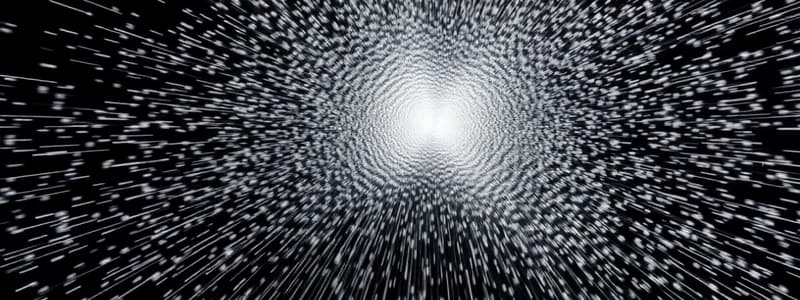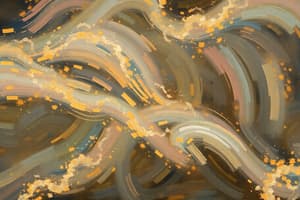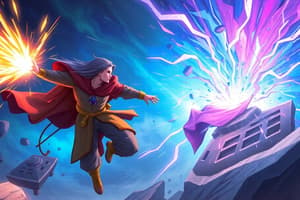Podcast
Questions and Answers
What is the primary difference between a push and a pull in the context of force?
What is the primary difference between a push and a pull in the context of force?
- A push is applied vertically, while a pull is applied horizontally.
- A push is a force exerted away from the object, while a pull is exerted towards it. (correct)
- A push involves contact force, while a pull can be a non-contact force.
- A push moves objects closer, while a pull moves them away.
Which of the following examples demonstrates force being applied as a push?
Which of the following examples demonstrates force being applied as a push?
- A caretaker pushing a baby stroller. (correct)
- A bellboy pulling a luggage trolley.
- A gardener pulling a grass roller on the lawn.
- A bull pulling a cart.
In which scenario is force applied as a pull?
In which scenario is force applied as a pull?
- A child pushing a toy car.
- A door being opened by pulling the handle. (correct)
- A person leaning against a wall.
- A car being pushed when it doesn't start.
What defines the concept of force?
What defines the concept of force?
Which statement about force is NOT true?
Which statement about force is NOT true?
What is the direction of the frictional force when an object is moved on a surface?
What is the direction of the frictional force when an object is moved on a surface?
Which term is used to describe the force by which Earth attracts a body towards its center?
Which term is used to describe the force by which Earth attracts a body towards its center?
How is weight expressed in terms of units?
How is weight expressed in terms of units?
What characterizes non-contact forces?
What characterizes non-contact forces?
What happens when like charges are brought close to each other?
What happens when like charges are brought close to each other?
What happens to a moving object when a force is applied in the direction of its motion?
What happens to a moving object when a force is applied in the direction of its motion?
How does applying brakes to a vehicle affect its motion?
How does applying brakes to a vehicle affect its motion?
What effect does squeezing a piece of rubber have?
What effect does squeezing a piece of rubber have?
What is the impact of a force applied from an angle to the direction of motion?
What is the impact of a force applied from an angle to the direction of motion?
Which of the following scenarios illustrates a force speeding up a moving body?
Which of the following scenarios illustrates a force speeding up a moving body?
What would happen if a force is exerted on a stationary object?
What would happen if a force is exerted on a stationary object?
When a football is kicked, what is primarily being applied?
When a football is kicked, what is primarily being applied?
What can be inferred about the relationship between force and motion?
What can be inferred about the relationship between force and motion?
What type of force acts on bodies without direct contact?
What type of force acts on bodies without direct contact?
What is the primary characteristic of contact forces?
What is the primary characteristic of contact forces?
Which of the following is an example of a non-contact force?
Which of the following is an example of a non-contact force?
What defines a force according to the content?
What defines a force according to the content?
What happens to two equal and opposite forces acting on a body?
What happens to two equal and opposite forces acting on a body?
Which statement about force is NOT true?
Which statement about force is NOT true?
What is the SI unit of force?
What is the SI unit of force?
Which scenario illustrates the principle of a spring balance?
Which scenario illustrates the principle of a spring balance?
How does a push typically affect a body compared to a stretch?
How does a push typically affect a body compared to a stretch?
Which of the following is an example of using force as a push?
Which of the following is an example of using force as a push?
What effect does pushing a bulldozer have on rubble?
What effect does pushing a bulldozer have on rubble?
In which scenario is force applied as a push?
In which scenario is force applied as a push?
What is a common everyday example of force as a push?
What is a common everyday example of force as a push?
What is the effect of a force applied to a body initially at rest?
What is the effect of a force applied to a body initially at rest?
Which scenario demonstrates a force applied to stop a moving body?
Which scenario demonstrates a force applied to stop a moving body?
Which of the following actions would likely lead to a change in the shape of an object due to applied force?
Which of the following actions would likely lead to a change in the shape of an object due to applied force?
If a moving baseball is caught by a fielder, what kind of force is being applied?
If a moving baseball is caught by a fielder, what kind of force is being applied?
What happens to a body at rest when an unbalanced force is applied?
What happens to a body at rest when an unbalanced force is applied?
What effect does a force have when applied in the opposite direction of a moving object?
What effect does a force have when applied in the opposite direction of a moving object?
When a force stretches a rubber band, which change is observed?
When a force stretches a rubber band, which change is observed?
In which scenario would a balanced force be present?
In which scenario would a balanced force be present?
Flashcards are hidden until you start studying
Study Notes
Effects of Force
- A force can change the motion of a body by altering its direction, speed, or state (rest or motion).
- Changing Direction: Striking a falling cardboard changes its path due to the applied force.
- Increasing Speed: A cyclist applies more force on the pedal to accelerate the bicycle.
- Slowing Down: Brakes on a vehicle apply force opposite to motion, reducing speed.
- Changing Shape/Size: Applying force to a non-moving body can deform it, like squeezing rubber.
Types of Force
- Forces can be classified as Contact Forces or Non-contact Forces.
- Contact Forces: Act upon objects that are in direct contact (e.g., friction, muscular force).
- Non-contact Forces: Act at a distance without direct contact (e.g., gravitational force, electrostatic force).
Nature and Components of Force
- Force is essentially a push or pull that causes movement or change in the state of an object.
- Force as Push: Moving objects like a trolley or car require a pushing force.
- Force as Pull: Moving objects like a grass roller is accomplished by pulling.
Force of Gravity
- The weight of a body is the gravitational force exerted by Earth, pulling it downward.
- This force defines why objects fall vertically (e.g., leaves dropping from a tree).
Frictional Force
- Friction is a contact force acting against the direction of motion, opposing movement.
Measurement of Force
- The SI unit of force is the newton (N). Other units include kilograms-force (kgf) and gram-force (gf).
- Force is calculated as the combination of magnitude and direction.
Balanced and Unbalanced Forces
- Forces that do not change a body's state (rest to motion, or vice versa) are balanced forces.
- Forces that can alter a body’s state are referred to as unbalanced forces.
Effects of Applying Force
- Moving a Resting Object: A force can initiate motion in objects that are at rest (e.g., a car when pushed).
- Stopping a Moving Object: Applying opposing force stops moving objects (e.g., brakes on a train).
- Stretching and Squeezing: Forces can modify an object's shape or size (e.g., stretching a spring or squeezing a balloon).
Everyday Examples of Force
- Opening a door or moving heavy objects (push).
- Pulling a door open or a cart (pull).
- Stretching rubber or wires applies to the concept of stretching forces.
- Squeezing a toothpaste tube or an inflated balloon leads to changes in shape/size.
Summary of Key Principles
- Force is a fundamental cause of motion and change.
- Effects of force encompass moving, stopping, accelerating, and deforming objects.
- Understanding force involves recognizing the distinction between contact and non-contact forces.
Studying That Suits You
Use AI to generate personalized quizzes and flashcards to suit your learning preferences.




